a8b6ed71e08545f608648e1f1258958a.ppt
- Количество слайдов: 84

Lethal Exposures: CO and CN (Carbon Monoxide and Cyanide) Mike Mc. Evoy, Ph. D, RN, CCRN, REMT-P EMS Coordinator – Saratoga County, New York EMS Editor – Fire Engineering Magazine

Disclosures • I am on the speakers bureaus for Masimo Corporation, Physio Control and Dey, LLP. • I am the Fire/EMS technical editor for Fire Engineering magazine. • I do not intend to discuss any unlabeled or unapproved uses of drugs or products. www. mikemcevoy. com




Learning Objectives 1. HCN and CO exposure, incidence, sources 2. Pathophysiology, clinical effects, sequelae 3. Diagnostic challenges, treatment issues 4. Solutions, assessment

Carbon Monoxide

Carbon Monoxide Firefighter Injuries – 2010 (United States): • Total injuries = 71, 875 • Smoke or Gas Inhalation = 2. 1% • Burns & Smoke Inhalation = 0. 9% = 3. 0% - NFPA Survey of Fire Depts for U. S. Fire Experience, 2010.

Carbon Monoxide (CO) “The Great Imitator” • Invisible • Masquerades

CO Poisoning: The Great Imitator 30 -50 % of CO-exposed patients presenting to Emergency Departments Barker MD, are misdiagnosed et al. J Pediatr. 1988; 1: 23343 Barret L, et al. Clin Toxicol. 1985; 23: 30913 Grace TW, et al. JAMA. 1981; 246: 1698700

Case Study § 26 yo female visits PMD c/o severe headaches unrelieved by repeated doses of Excedrin® - has been home alone, 2 children visiting with exhusband § Neuro exam WNL, no other findings. Dx sinusitis. Tx Amoxil and T 3’s § Next day: h/a worse, now vomiting, calls EMS, transport to ED § MD evaluates, no specific findings. Tx IV fluids, antiemetic, analgesic, head CT (neg). Given phenergan Rx, f/u with PMD § Arrives home by taxi, ex-husband waiting to return children

Case Study continued… § Next morning, same headache. Children difficult to awaken, once awake both have trouble walking, stumble and fall. § EMS summoned, FD also dispatched. CO metering finds 1, 200 to 1, 600 ppm from bedroom space heater. Dead kitten found in children’s room. All three transported. § Mom 29% COHb – sent for HBO, home 48 hours later. 4 yo son 14%, 2 yo daughter 17% - both admitted to regional children’s hospital for 24 hours observation. § Mom with permanent neurological deficit, children no sequelae.

Carbon Monoxide (CO) • Gas: • Colorless • Odorless • Tasteless • Nonirritating • Physical Properties: • Vapor Density = 0. 97 • LEL/UEL = 12. 5 – 74%

Endogenous Sources of CO • Normal heme catabolism (breakdown): • Only biochemical reaction in the body known to produce CO • Hemolytic anemia • Sepsis, critical illness…

Common Sources 1. Incomplete combustion of any carbon-based material will produce carbon monoxide. Most commons sources are: • • Automobiles, trucks, buses, boats Gas heaters and furnaces Small gasoline engines Portable / space heaters Portable gas-powered generators Barbecues / fireplaces Structure / wildland fires Cigarette smoke 2. Methylene chloride (paint stripper) - liver converts to CO

CO Exposure Source Exposure (ppm) Fresh Air 0. 06 -0. 5 Urban Air 1 -30 Smoke-filled Room Cooking on Gas Stove Smoking a Cigarette Automobile Exhaust 2 -16 100 400 -500 100, 000 § Environmental exposure typically <0. 001% (10 ppm). § Higher in urban areas. § Sources: § Volcanic gasses § Brush fires

Severity of Intoxication: Morbidity Associated with COHb and Duration Highlighted Area demonstrates current OSHA Standard for CO: [500 ppm/30 minutes] Consider 500 ppm/60 -90 minutes….

Case Study: Even Low Exposure Levels Can Lead to Death • 52 yo male • Prominent attorney in Salt Lake City found dead in his home after failing to show up for work • Had complained to co-workers of nausea and other flu-like symptoms for several days • Upon discovery of his body, elevated levels of CO were discovered in the home—but levels were relatively low, only 130 PPM • Faulty boiler discovered Even 130 Parts Per Million Over a Prolonged Period Can Kill You!

Carbon Monoxide Poisoning • Leading cause of poisoning deaths in industrialized countries: 50, 000 emergency room visits in the US annually 1 • At least 3, 800 deaths in the US annually 2 • 1, 400 -3, 000 accidental deaths in the US annually 3, 4 • • Even a single exposure has the potential to induce long-term cardiac and neurocognitive/psychiatric sequelae: • Brain damage at 12 months after exposure is significant 5 1 2 Myocardial Injury is a common consequence of CO poisoning and can identify patients at a higher risk for Mott JA, Wolfe MI, Alverson CJ, Mac. Donald SC, Bailey CR, Ball LB, Moorman JE, Somers JH, Mannino DM, Redd 6 SC. Nationalpremature death practices and declining US carbon monoxide-related mortality. JAMA Vehicle Emissions policies and • Hampson NB, Weaver LK. Carbon Monoxide poisoning: A new incidence for an old disease. Undersea and Hyperbaric Medicine 2007; 34(3): 163 -168. 2002; 288: 988 -995 3 Hampson NB, Stock AL. Storm-Related Carbon Monoxide Poisoning: Lessons Learned from Recent Epidemics. Undersea Hyperb Med 2006; 33(4): 257 -263 4 Cobb N, Etzel RA, Unintentional Carbon monoxide-related deaths in the United States, 1979 through 1988. JAMA 1991; 266(5): 659. 5 Weaver 6 Henry LK, et al. N Engl J Med, 2002; 347(14): 1057 -067. CR, et al. JAMA. 2006; 295(4): 398 -402.

Incidence • Increased accidental CO deaths: • Patient > 65 years of age. • Male • Ethanol intoxication. • Accidental deaths peak in winter: • Use of heating systems. • Closed windows. • Significant increase seen following disasters: • Related to utility loss.

Show me the money…Is this real? § 104 CCU admissions UAP: 3 CO toxic, 5 others minor exposure (> smoker). Balzan et al, Postgrad Med J, 1994; 70: 699 -702 Up to 10% of UAP, ACS, seizure, and h/a admits Postgrad Med J, 1996; 72: 470 -3. have CO 5 poisoning w/ § 168 acute neuro admits: CO toxic (2 from group § 307 acute neuro admits: 3 CO toxic (all from group of 29 w/ decr. LOC absent focal s/s). Balzan et al, seizures) Heckerling et al, Clin Toxicol, 1990; 28: 29 -44. § 48 h/a pts: 7 COHb > 10% (14. 6%, all unrelated to smoking) Heckerling et al, Am J Emer Med, 1987; 5: 201 -4. § 146 h/a pts: 4 COHb > 10% (3%, all unrelated to smoking) Heckerling et al, Ann Intern Med, 1987; 107: 174 -6.

Attempts to Develop a Model § Heckerling et al apply criteria to validate a predictor model for identifying CO poisoned pts. In ED. § 61 patients tested, model only detects 3 of 4 pts with COHb Heckerling et al, Am J Med 1988; 84: 251 -6. § 753 acute admits med-surg, neuro, psych: 2 w/ minor COHb Heckerling et al, Am J Emerg Med 1990; 8: 301 -4. § Conclusion: Widespread ED screening expensive, unproductive unless quick and cheap screening tool became available.

Pathophysiology • CO displaces O 2 from hemoglobin binding sites (4) • CO prevents O 2 from binding • (carboxyhemoglobin) • COHb increases O 2 affinity, interfering with normal release

Messy Pathophysiology • Complex IV of Electron Transport Chain – binds cytochrome c oxidase • CO does NOT bind with same affinity as O 2 (requires significant hypoxia)

Pathophysiology • CO limits oxygen transport • Greater affinity (>210 x) for hemoglobin • Inhibits oxygen transfer • Interferes with normal unloading to tissues • Binds with myoglobin (muscle) • Interferes with heart and skeletal muscle fxn • Binds to cytochrome oxidases • Induces anerobic metabolism (cellular & tissue) • Increases nitric oxide (NO) formation • Accelerates free radical formation

Pathophysiology - Effects • Hypoxia • Cellular, cardiac and cerebral • Intracellular toxicity • Cardiac and skeletal muscle dysfunction • Inflammatory response • Secondary to hypoxia • Vasodilation • Induced by NO release (hypotension) • Free radical formation • Endothelial and oxidative cerebral damage

Neurologic Effect Delayed Neurologic Syndrome Experienced by 11 -30% of patients with CO Harper A et. al, Age and Ageing. Poisoning (DNS) 2004; 33(2): 1059. Kao LW et. al, Emerg Med Clin North Am. 2004 Weaver LK, et al. N Engl J Med, 2002; 347(14): 1057 -067 Long-Term/Chronic Sequelae Cognitive and personality changes, dementia, seizures, psychosis, amnesia, Abelsohn A, CMAJ 2002: 166 parkinsonism, depression, (13): 1685 -90 short-term memory loss,

Case Studies: Neurological Sequelae • 51 yo female Physical Therapist • Iditarod racer stopped to change wet socks in a tent • Experienced nausea, then lost consciousness • Inhaled CO from a faulty propane heater for 3 hours • Prolonged recovery, IQ fell • 32 from 140 to & 35 yoto relearn yo female 76, had male reading Attorneys & writing • CO from inadequately ventilated furnace • Both unable to function as attorneys

Cardiac Effect • “Myocardial injury occurs frequently in patients hospitalized for moderate to severe CO poisoning and is a significant predictor of mortality” • Odds ratio’s from recent study demonstrate that a patient has a 3 times higher likelihood of cardiac death (within a 7 year follow-up period) from even Myocardial Injury and Long-Term Mortality one moderate to severe toxic Following Moderate to Severe Carbon Monoxide CO exposure, when compared Poisoning. Henry CR, Satran D, Lindgren B, Adkinson C, Nicholson C, Henry to a control group TD. JAMA. 2006; 295(4): 398 -402

Cardiac Effect • 19 year study 8, 333 Swedish males ÷ smokers, non-smokers, never smokers. • Never smokers split into quartiles: • 0. 13 – 0. 49% COHb • 0. 50 – 0. 57% • 0. 58 – 0. 66% • 0. 67 – 5. 47% • Relative risk CV event 3. 7, death 2. 2 highest to lowest quartiles COHb% as a marker of cardiovascular risk in never smokers: Results from a population-based Incidence CV disease & death in cohort study. Hedblad BO, Engstrom G, Janzon non-smokers related. Pub Health. E, Berglund G, Janzon L. Scand J to COHb% 2006; 34: 609 -615. •

Firefighters and CO • Study of 64 firefighters in training exercise • Baseline COHb readings: 03% (via exhaled CO monitor with error of 1%) • Maximum CO in a firefighter wearing SCBA: 3% • Values in instructors not wearing BA: 14%, 5%, and 4% Noninvasive fireground assessment of carboxyhemoglobin levels in firefighters. Cone DC, et al. Prehosp Emerg Care. 2005; 9: 8 -13

CO Assessment in FF Rehab? • Suggested in NFPA 1584 • CO induces death 2° VF in animal lab • VF initial rhythm in 90% interior FF deaths • Should not leave rehab if > 5% COHb



Fetal Damage Theoretical effect of different treatments on maternal and fetal COHb levels over time Rucker J, Fisher J, Carbon Monoxide Poisoning, Chapter 63 Longo LD: The biological effects of carbon monoxide on the pregnant woman, fetus, and newborn infant. Am J Obstet Gynecol 1977; 129: 69 -103.

Haunted Houses or CO Poisoning? • Wilmer W. “Mr. and Mrs. H. ” Amer J Opthamology. 1921 • Purchased new home, c/o headaches & fatigue. Heard bells and footsteps during nights with sightings of mysterious figures. • Investigation revealed prior owners had similar experiences. • Furnace chimney found blocked, venting CO into home.

CO Alarms • 61, 100 CO incidents in 2005 • Increase 9% each year (= 100, 490 in 2011) • Peak December & January and 6 -10 PM • 92% residential NIFRS Source:

UL 2034: listings for CO alarms • Revised 1992, 1995, 1998 • Presently: • 30 PPM for 30 days • 70 PPM for 1 – 4 hours • 150 PPM for 10 – 50 minutes • 400 PPM for 4 – 15 minutes (6 min reset > 70 PPM) • Non-alarm status CO 2 < 5, 000 PPM • Non-alarm limits for methane, butane, heptane, ethyl acetate and isopropyl 720 - NFPA

Signs and Symptoms Sp. CO% <5% 5 -10% Clinical Manifestations None Mild headache, tire easily 11 -20% Moderate headache, 21 -30% 31 -40% 41 -50% 51 -60% exertional SOB Throbbing headache, mild nausea, dizziness, fatigue, slightly impaired judgment Severe headache, vomiting, vertigo, altered judgment Confusion, syncope, tachycardia Seizures, unconsciousness Carbon Monoxide Poisoning Presents Like the Flu!

Laboratory CO-oximetry • CO-oximetry capability found in 50% of hospital laboratories • Standard ABG cannot differentiate carboxy from oxyhemoglobin • Invasive—need compelling reason to order, repeated tests to monitor tx • Variable time to analysis (can take from minutes to hours to get results) • Golden Standard—for measurement and/or detection

Blood Sampling for COHb § A-COHb = V-COHb Touger et al, Ann Emerg Med, 1995; 25: 481 -3. 61 suspected CO poisoning patients @ Bronx Municipal Hospital ED, simultaneous A and V sampling COHb. Correlation r value 0. 99 (95% CI, 0. 99 to 0. 99), r 2 value 0. 98. CONCLUSION: “Arterial and venous COHb levels only rarely differ by more than 1% to 2%. ”

Limitations of Pulse Oximetry Conventional pulse oximetry can not distinguish between COHb, a From Conventional Pulse Oximeter Sp. CO-Sp. O 2 Gap: The fractional difference between actual Sa. O 2 and display of Sp. O 2 (2 wavelength oximetry) in presence of carboxyhemoglobin From invasive CO-Oximeter Blood Sample [Blood] Barker SJ, Tremper KK. The Effect of Carbon Monoxide Inhalation on Pulse Oximetry and Transcutaneous PO 2. Anesthesiology 1987; 66: 677 -679

Exhaled CO Meters § Estimation COHb from alveolar CO concentration first described in 1948 (Sjostrand T. Acta Physiol Scand 16: 201 -7) § Predominantly used to monitor smoking cessation § Compact, portable, well validated www. micro-direct. com § Requires 20 second breath holding, measures ETCO in PPM § Present accuracy + 2 PPM, COHb obtained from Haldane Equation (essentially = PPM ÷ 6)

Exhaled CO Meters § Fast, economical, portable § CPT Code (94250) § Requires 20 second breath hold (awake, alert patient) § Disposable mouthpieces § Regular gas calibration § Despite widespread availability since 1970’s utilization very low

Noninvasive Pulse CO-Oximetry § FDA approved January 2006 § Compact, portable, well validated § CPT Code (82375 Sp. CO, 83050 Sp. Met) § Continuous carboxyhemoglobin measurement § Present accuracy + 3 % COHb § Also measures oxyhemoglobin (Sp. O 2), methemoglobin (Sp. Met), perfusion index (PI), approved for hemoglobin (Sp. Hb) in 2010. § No calibration needed www. masimo. com

Pulse CO-Oximetry § Fast, economical § Can be used on any patient (including unconscious) § No disposables § No calibration necessary § Use wider than exhaled devices after very short time in marketplace

How Noninvasive Pulse CO-Oximetry Works Oxygenated Hb and reduced Hb absorb different amounts of Red (RD) and Infrared (IR) Light (Two-wavelength oximeters cannot measure dyshemoglobins)

FDA Validation Masimo Rainbow SET Compared to Reference Methodology Red

Treating CO Poisoning - Oxygen

Treatment of CO Poisoning • Chemical Half-life of Carbon Monoxide bound to Hemoglobin • 4 hours on room air • 45 minutes on 100% oxygen • 22 minutes on 100% in Hyperbaric Chamber at 2 -4 atmospheres

Hyperbaric Oxygen Treatment Rate of cognitive sequelae was nearly twice as high when hyperbaric treatment was not used • Methods • Random assignment of symptomatic patients with CO poisoning into one of two groups • Group 1: 3 hyperbaric oxygen treatments in a 24 hour period • Group 2: 1 normobaric oxygen treatment and two normobaric room air treatments • Results Group 1: 25% sequelae at 6 weeks, 18 % at 12 months • Group 2: 46% sequelae at 6 weeks, 33% at 12 months • Weaver LK et al, Hyperbaric Oxygen for Acute Carbon Monoxide Poisoning, N Engl J Med 2002; 347(14) : 1057067

CO Assessment 1. Every patient, every time. 2. All occupants at CO alarm calls. 3. Firefighters.

Protocols for EMS JEMS suppl Oct 2010 Protocols: 1. Routine care 2. FF Rehab 3. Response to CO alarms

14, 438 Patient Brown University Study • Partridge and Jay (Rhode Island Hospital, Brown University Medical School), assessed carbon monoxide (CO) levels of 10, 856 ED patients • 11 unsuspected cases of CO Toxicity (COT) were discovered. Overall mean Sp. CO was 3. 60% • Occult COT was 4 in 10, 000 during cold, 1 in 10, 000 during warm months • They concluded “unsuspected COT may be identified using noninvasive COHb screening and the prevalence of COT may be higher than Non-Invasive Pulse CO-Oximetry in the Emergency Identifies previously recognized” Screening Partridge R, Sucov. Department J, Chee K, Occult Carbon Monoxide Toxicity. Suner S, A, Valente Hughes A, Jay G. J Emerg Med 2008 Department of Emergency Medicine, Rhode Island Hospital, Brown Medical School, Providence, RI.


Hydrogen Cyanide (CN) • Toxic Gas: • Colorless or pale blue • Faint bitter almond odor* • Irritating • Burning taste • Physical Properties: • Vapor Density = 0. 94 • *Up to 40% of = 5. 6 – 40% to detect HCN odor LEL/UEL population unable • IDLH = 50 ppm

Cyanide in Fire Smoke Natural Substances: • Wool • Silk • Cotton • Paper Synthetic Substances: • Plastics • Nylons • Styrofoam • Polyurethane foam

Trends in Construction Shift from wood & natural to lightweight materials (read synthetics and petroleum based products) = • Ignite 2 – 3 times faster (not hotter, fire is fire) • Emit significant HCN during pyrolysis 1. Less time to escape (shorter time to flashover) 2. Toxic gases incapacitate 3. Increased risk of injury (thermal, inhalation)

Fire in the United States - 2010 • 1, 331, 500 reported fires • 3, 120 civilian deaths • 17, 720 civilian fire injuries • (87) firefighter deaths (= 72 + 15) • (14) during interior firefighting • US fire fatality rate remains double those of Western Europe and Japan where smoke exposures are aggressively treated.

Causes of Civilian Fire Deaths

Fire in the United States - 2010 • 1, 331, 500 reported fires • 3, 120 civilian deaths Firefighter Injuries – 2010 (United States): • 17, 720 civilian fire injuries • Total injuries = 71, 875 • (87) firefighter deaths (= 72 + 15) • Smoke during interior firefighting (2. 1%) or Gas Inhalation = 1, 500 • (14) • Burns & Smoke Inhalation = 635 (0. 9%) • US fire fatality rate remains double those of = 3. 0% Western Europe and Japan where smoke exposures areof Fire Depts for U. S. Fire Experience, 2010. - NFPA Survey aggressively treated.

Station Nightclub Fire - RI • Feb 2003 band pyrotechnics ignite polyurethane foam lining stage walls • 440 people, 100 deaths

Simulation of platform area • 60 seconds flashover • 90 seconds – CO, CN, O 2 incompatible with life

NIST Simulation
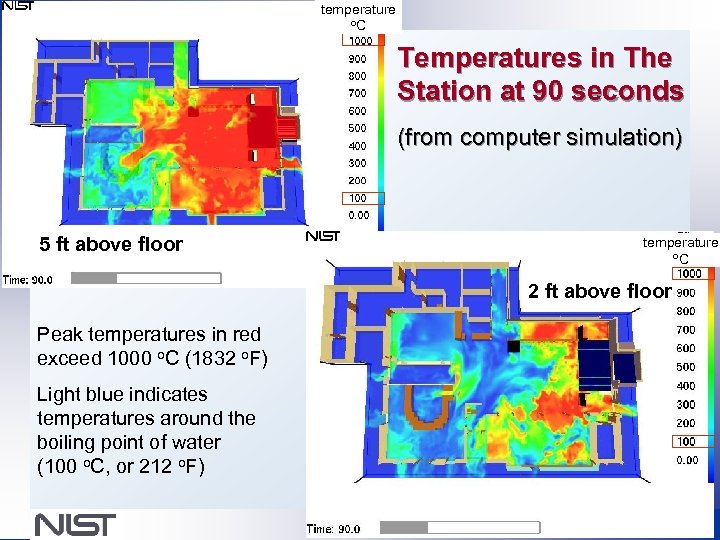
temperature o. C Temperatures in The Station at 90 seconds (from computer simulation) 5 ft above floor temperature o. C 2 ft above floor Peak temperatures in red exceed 1000 o. C (1832 o. F) Light blue indicates temperatures around the boiling point of water (100 o. C, or 212 o. F)

Percentage of fire deaths CN & CO: Exposure in Fire Deaths COHb, carboxyhemoglobin; FFS, Foundation for Fire Safety. Adapted from Alarie Y. Crit Rev Toxicol. 2002; 32: 259 -289.

Progression of CN Poisoning Time since exposure (seconds to hours) Stupor Loss of consciousness Death Drowsiness Hypoventilation Giddiness Palpitations Dizziness Nausea/vomiting Hyperventilation Eye irritation Concentration of exposure (low to high) Holstege CP, et al. In: Flomenbaum NE, et al, eds. Goldfrank’s Toxicologic Emergencies. 8 th ed. New York, NY: Mc. Graw-Hill; 2006: 1712 -1757.

March 21, 2003 – Cincinnati, Ohio • Flashover @ single family house fire • 3 interior crew members, 2 proceeded out front door • FF Oscar Armstrong III, aged 25, acting strangely • Cause of death = massive 3 rd degree burns • ? FF disorientation secondary to cyanide inhalation
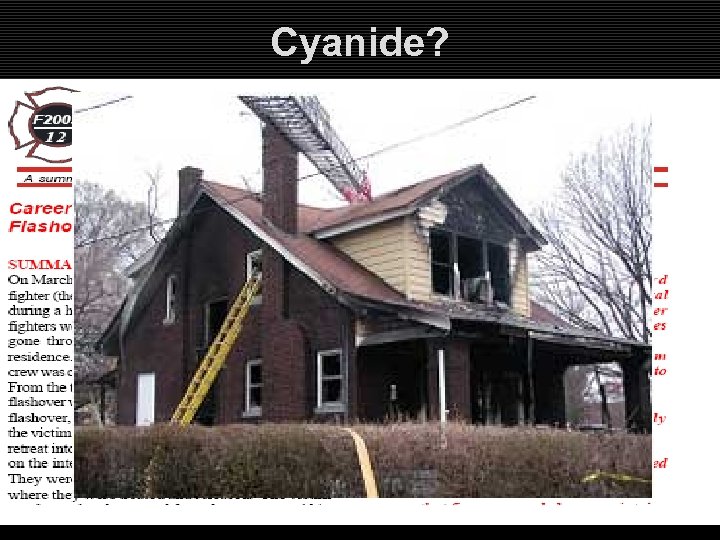
Cyanide?

Paris Fire Brigade Protocol 1. Known smoke exposure in enclosed space 2. Altered mental status 3. Soot in nares or mouth

Paris Fire Brigade Protocol ROSC = 50%
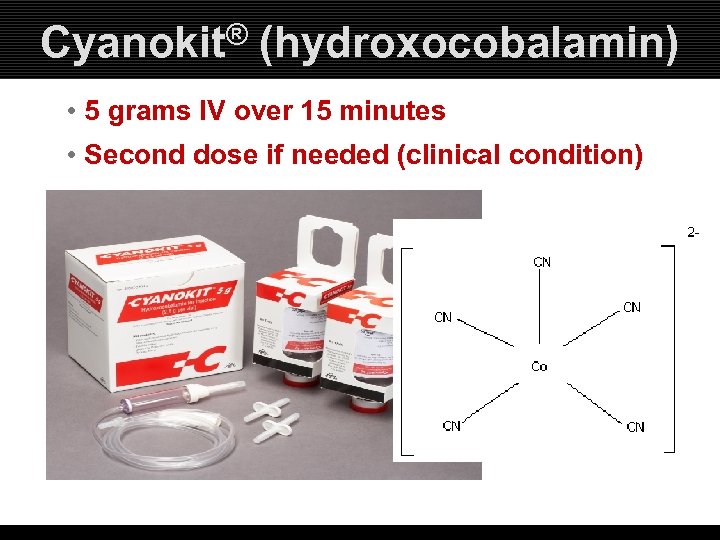
Cyanokit® (hydroxocobalamin) • 5 grams IV over 15 minutes • Second dose if needed (clinical condition)
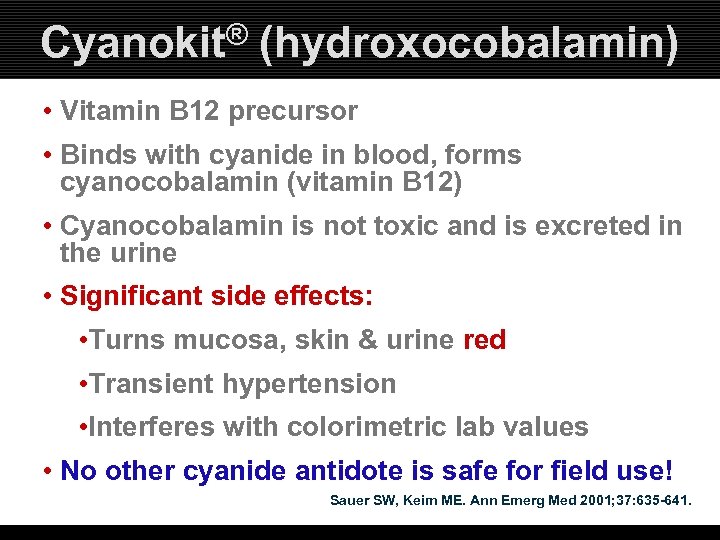
Cyanokit® (hydroxocobalamin) • Vitamin B 12 precursor • Binds with cyanide in blood, forms cyanocobalamin (vitamin B 12) • Cyanocobalamin is not toxic and is excreted in the urine • Significant side effects: • Turns mucosa, skin & urine red • Transient hypertension • Interferes with colorimetric lab values • No other cyanide antidote is safe for field use! Sauer SW, Keim ME. Ann Emerg Med 2001; 37: 635 -641.

Skin Redness in Healthy Volunteers After 10 g treatment, photos on Day 1 and on Day 8. Day 1* Day 8† *No flash photography. †Flash photography used. OHCo, hydroxocobalamin. Uhl W, et al. Clin Toxicol. 2006; 44: 17 -28.

HCO 5 g: Systolic Blood Pressure Systolic blood pressure (mm. Hg) 170 160 150 Hydroxocobalamin 5 g Placebo 140 130 120 110 100 90 pre d: 5 d: 15 0: 20 0: 40 1: 00 1: 20 1: 40 2 4 8 Time (min) Time (h) relative during infusion to the end of infusion 12 24 Uhl W, et al. Clin Toxicol (Phila). 2006; 44 Suppl 1: 17 -28.
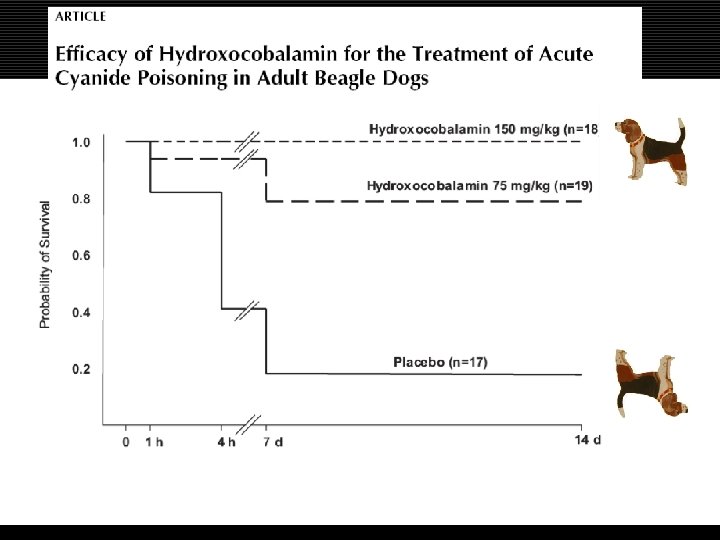
Borron Clin Tox 2006
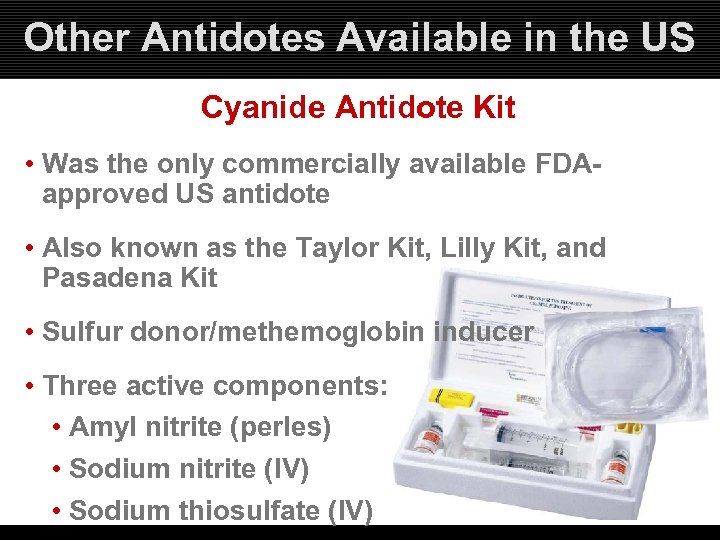
Other Antidotes Available in the US Cyanide Antidote Kit • Was the only commercially available FDAapproved US antidote • Also known as the Taylor Kit, Lilly Kit, and Pasadena Kit • Sulfur donor/methemoglobin inducer • Three active components: • Amyl nitrite (perles) • Sodium nitrite (IV) • Sodium thiosulfate (IV)
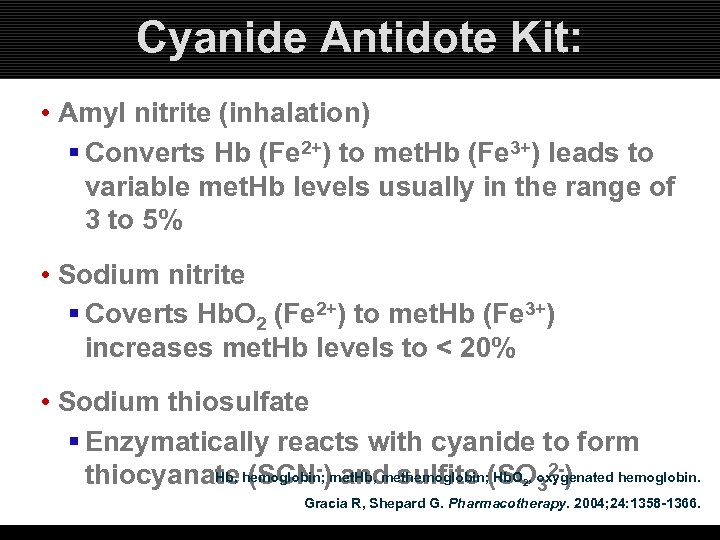
Cyanide Antidote Kit: • Amyl nitrite (inhalation) § Converts Hb (Fe 2+) to met. Hb (Fe 3+) leads to variable met. Hb levels usually in the range of 3 to 5% • Sodium nitrite § Coverts Hb. O 2 (Fe 2+) to met. Hb (Fe 3+) increases met. Hb levels to < 20% • Sodium thiosulfate § Enzymatically reacts with cyanide to form Hb, (SCN- and sulfite Hb. O , 2 -) thiocyanate hemoglobin; )met. Hb, methemoglobin; (SOoxygenated hemoglobin. 3 2 Gracia R, Shepard G. Pharmacotherapy. 2004; 24: 1358 -1366.

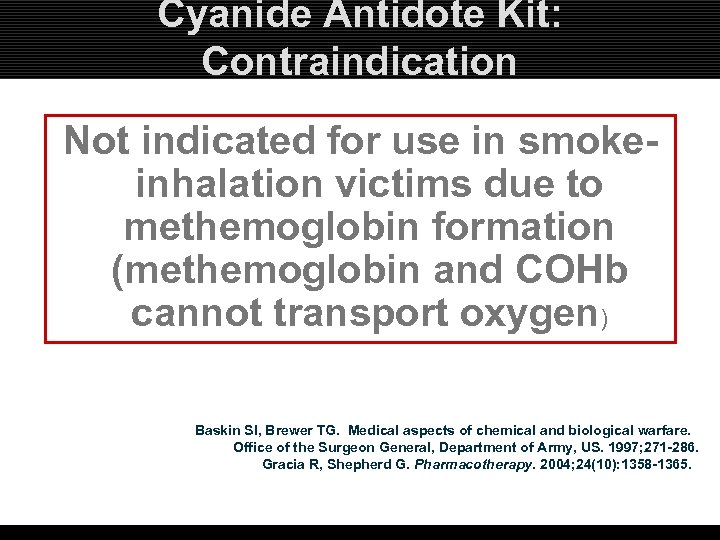
Cyanide Antidote Kit: Contraindication Not indicated for use in smokeinhalation victims due to methemoglobin formation (methemoglobin and COHb cannot transport oxygen) Baskin SI, Brewer TG. Medical aspects of chemical and biological warfare. Office of the Surgeon General, Department of Army, US. 1997; 271 -286. Gracia R, Shepherd G. Pharmacotherapy. 2004; 24(10): 1358 -1365.
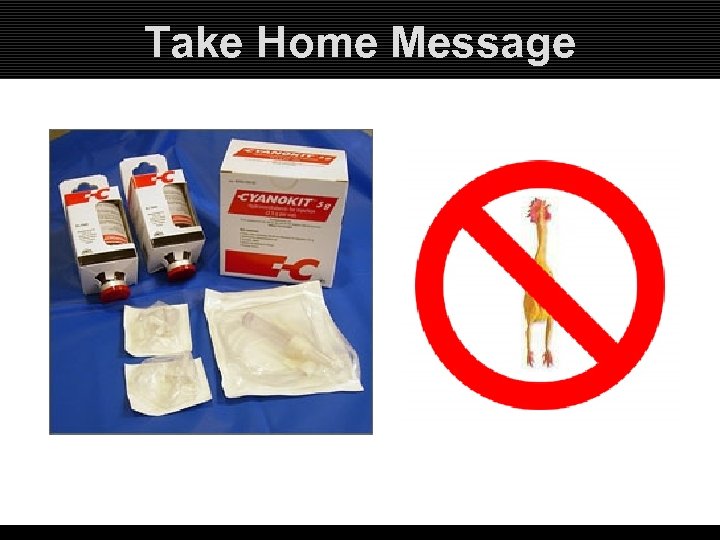
Take Home Message
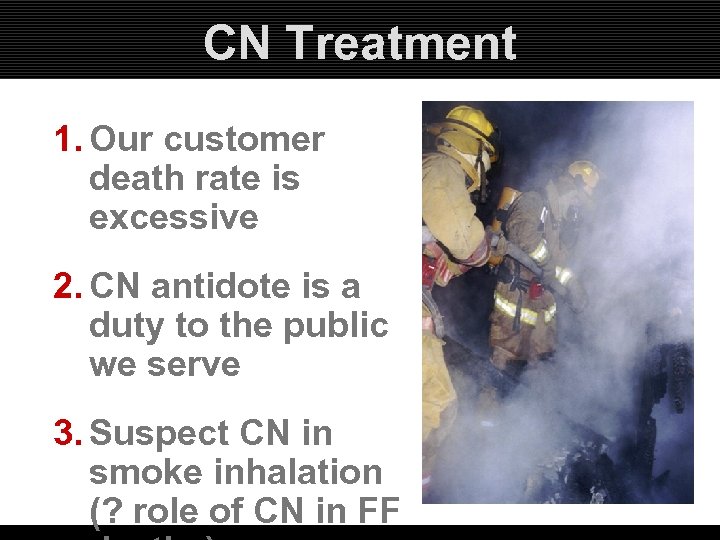
CN Treatment 1. Our customer death rate is excessive 2. CN antidote is a duty to the public we serve 3. Suspect CN in smoke inhalation (? role of CN in FF
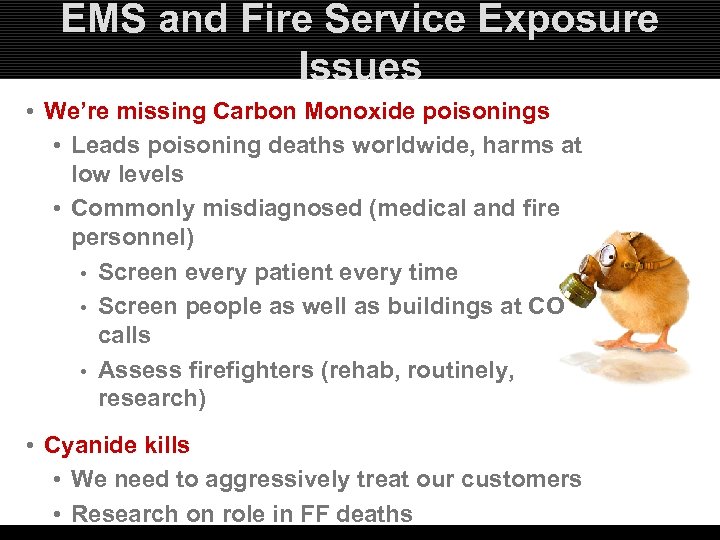
EMS and Fire Service Exposure Issues • We’re missing Carbon Monoxide poisonings • Leads poisoning deaths worldwide, harms at low levels • Commonly misdiagnosed (medical and fire personnel) • Screen every patient every time • Screen people as well as buildings at CO calls • Assess firefighters (rehab, routinely, research) • Cyanide kills • We need to aggressively treat our customers • Research on role in FF deaths

Thank You mcevoymike@aol. com www. mikemcevoy. com
a8b6ed71e08545f608648e1f1258958a.ppt